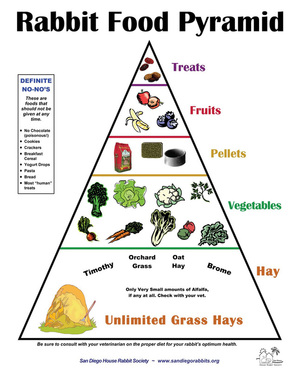HayHay and its role for your disabled rabbit.
High quality fresh hay is important for all rabbits, but even more so for the disabled rabbit. Hay is rich in vitamins A and D, as well as protein, calcium, and other nutrients. It is also a critical source of fiber and is essential for a healthy gastrointestinal tract and overall digestive system. As disabled rabbits often face digestion difficulties and can develop GI stasis and other digestive problems much more easily than other rabbits, it is very important that their owners ensure they receive as much hay as possible.
As a general rule, your rabbit should be eating about their size in hay each day and it should be making up approximately 80% of your rabbit's diet. Always allow your rabbit unlimited access to hay all day long. Here are the age guidelines for feeding hay:
|
Types of Hay
There are a number of different hays to choose from, each with its own taste and texture.
Alfalfa Hay
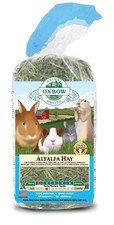
Alfalfa hay is a high-fiber legume hay with the same long-strand fiber found in grass hays, but with more protein, energy and calcium. This hay is sweet and extremely rich in fiber and nutrients, but due to its high calcium content it is not generally recommended as a primary hay source for rabbits over 1 year old. However, it IS great for disabled rabbits (as long as the rabbit does not have a history of sludge or calcium problems). Its sweet taste helps to encourage them to eat more hay and it assists with weight gain (which is especially important for paralyzed or partially paralyzed rabbits). Feel free to mix some alfalfa hay in with other types of hays for a nutritious hay blend for your disabled rabbit.
Analysis:
Analysis:
- Crude Protein min 16.00%
- Crude Fat min 1.50%
- Crude Fiber max 32.00%
- Moisture max 15.00%
Botanical Hay
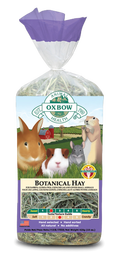
Botanical hay is a rich blend of herbs (chamomile, lavender, lemon balm and clover) with Western Timothy hay. It is designed to stimulate your rabbit's appetite for hay and add a little healthy variety to your rabbit's diet. Alternate or mix botanical hay with other hays to create appetizing, long-strand fiber meals.
Analysis:
Analysis:
- Crude Protein min 8.00%
- Crude Fat min 1.50%
- Crude Fiber max 32.00%
- Moisture max 15.00%
Meadow Hay
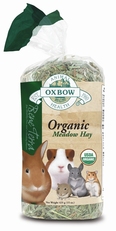
Meadow hay is composed of a variety of naturally occurring grass hays providing an enticing combination of textures, fragrances and flavors. It is softer than Timothy hay but is generally less sweet than other hays. This combination provides a nutritious hay that is high in fiber and low in protein to keep a rabbit's digestive tract functioning properly.
Analysis:
Analysis:
- Crude Protein min 10.0%
- Crude Fat min 1.50%
- Crude Fiber max 30.0%
- Moisture max 15.0%
Oat Hay
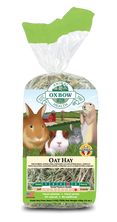
Oat hay is a grass blend made up of oat stems, leaves and seed heads harvested before the oat develops into a seed. Like all grass hays, it is high in fiber and low in protein, but its unique blend of tastes and textures makes it appealing even to the pickiest of eaters. This appealing alternative contains savory husks full of both flavor and fiber for a nutty-tasting and nutritious overall combination.
Analysis:
Analysis:
- Crude Protein min 7.00%
- Crude Fat min 1.50%
- Crude Fiber max 32.00%
- Moisture max 15.00%
Orchard Grass Hay
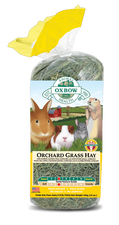
Orchard grass hay is a soft and aromatic green grass hay that is a great addition to any rabbit's healthy meal plan. It is a long-strand grass hay with flat blades that are sweet smelling and tasting while also being high in fiber and low in protein. It is a great everyday hay choice that supports your rabbit's health by stimulating digestion, preventing obesity and making mealtime more appealing.
*My personal favorite.
Analysis:
*My personal favorite.
Analysis:
- Crude Protein min 7.00%
- Crude Fat min 1.50%
- Crude Fiber max 32.00%
- Moisture max 15.00%
Western Timothy Hay
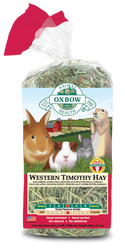
Western Timothy hay is the ideal long-strand fiber source for keeping rabbits' digestive tracts functioning properly. It is a hardy grass hay with high quality nutrition and a fresh fragrance. It has a selection of flat blades and hard stalks to suit all rabbit tastes. With its high fiber, low protein and low calcium content, it is widely recommended by veterinarians and is a staple in most rabbit homes.
Analysis:
Analysis:
- Crude Protein min 7.00%
- Crude Fat min 1.50%
- Crude Fiber max 32.00%
- Moisture max 15.00%
Our Favorite Hays
Crazy Tasty Hay by Bingaling Bunnybox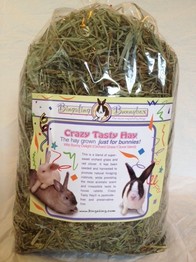
Crazy Tasty Hay by Bingaling Bunnybox is a premium hay that is grown exclusively for house rabbits. This hay has been seeded, grown and harvested for the tiny mouths and specific tastes of bunnies. It is bagged to order, shipped immediately, and never sits on a store shelf. It is also pesticide-free and preservative-free. It has an aroma like no other hay and is always farm-fresh.
|
Timothy Hay by Small Pet Select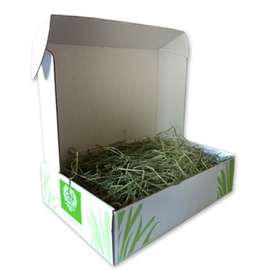
The Timothy Hay by Small Pet Select is a very sweet, soft and beautifully green selection of fiber-rich timothy hay. It is specifically selected for small animals and has an aroma so fragrant you can practically smell the meadows. It is hand packed and shipped fresh to your door.
|
Encouraging Your Disabled Rabbit to Eat More Hay
Given the struggles your disabled rabbit faces on a daily basis, it can be hard to get them to focus on healthy eating. Not eating enough hay puts them at risk of digestive and dental issues, so making an effort to entice them to eat more hay has real health benefits. Here are some tips for encouraging your rabbit to eat more hay:
- Try a new type of hay. As you can see from above, not all hays are the same. Each one has its own taste, fragrance and texture. If you feed a stockier hay, try a sweeter one. If you feed a broad-stemmed hay, try a thinner one. Encourage your rabbit to eat more by finding and feeding the hay they find most tasty.
- Try a mix of hays. Many rabbits are picky eaters and get bored when fed the same thing all the time. Try mixing it up with some new and varying types of hays to keep them interested.
- Incorporate hay into foods they enjoy. Tempt your rabbit by mixing fresh or dried herbs, vegetables, fresh grass or dry food into their hay. This makes their hay an incorporated food- not just something they can forage throughout the day. Plus, it is a great way to keep their minds (and teeth) occupied. This is also a good thing to try if you have a rabbit that just doesn't like hay. While searching through the hay for the foods they like, they may end up eating some hay and realize it is not so bad after all.
- Make sure hay is available to them when and where they want to eat it. This one is especially important for the disabled rabbit. Rabbits often eat hay when they are using their litter bin or when they are resting. A disabled rabbit may not be able to use a litter bin or may have trouble moving around. This means that they will need you to place hay in easy-to-reach places where they often like to be. If their hay is out of reach or tucked into a hay rack that they cannot reach, they may not be eating as much as they need to.
- Regulate the amount of other foods that you feed. Most rabbits will take something sweet over a piece of hay and many rabbits will shun hay for their pellets or oats. While other foods may be tastier, it is vital that your rabbit gets a balanced diet and not just the foods that taste best. Try decreasing the amount of dry food that you feed to encourage them to eat more hay, or feed hay throughout the day and give other foods at night.
- Incorporate hay into toys and games. Try to turn your rabbit's hay into something fun and exciting. If your rabbit is still able to use tunnels, put some hay inside or in front of the entrance. If they are interested in toys, put some hay into a paper towel roll or inside of a jingle ball for them to play with.
- Check how you are buying and storing your hay. Make sure that the hay you are buying is of good quality and properly stored both before and after you purchase it. High quality hay will smell sweeter, taste fresher and be more appealing to your rabbit. Also, don't compromise the freshness by storing the hay improperly. Many people do not realize this, but hay should NOT be stored in airtight containers or plastic bags. Instead store it in a cardboard box or in a cotton bag (such as a pillowcase) in cool, dry conditions.

